Effects of Face Masks on Physical Performance and Physiological Response during a Submaximal Bicycle Ergometer Test
Abstract
1. Introduction
2. Materials and Methods
2.1. Participants
2.2. Study Design, Research Aims and Sample Size
2.3. Procedures
2.4. Physical Working Capacity Tests and Face Masks
- MedMask (Figure 1A): Disposable medical face mask without exhaling valve (NITRAS Medical Care Dental GmbH, 4331//PROTECT, medical face mask, made of fiberglass-free non-woven fabric, blue, 3-ply, integrated nosepiece, round and latex-free elastic bands, manufactured according to EN 14683 Type IIRv). This type of mask has been chosen since in Germany it is the minimal legal requirement for infection prevention in occupational settings when the minimum distance cannot be guaranteed [2].
- FFP2exhal (Figure 1B): Disposable filtering face-piece mask with exhaling valve, protection class II (Honeywell, SuperOne 3206, VALVE, EN 149). This mask was used since suggested wear time limits in Germany for any face mask during the COVID-19 pandemic are based on working conditions where FFP2 masks with exhalation (FFPexhal) valve are used as protective measures against hazardous dust [10].
- Community mask (Figure 1C): Cotton mouth-nose-cover without exhaling valve (van Laack, Art.49.0946.Z51022.003, CE—2012-16632). A community mask was additionally included as an experimental condition because this type of mask can be used by the general public under the age of 60 and who do not have underlying health conditions according to the recommendation of the WHO [9].
2.5. Outcomes and Measurements
2.6. Data Analysis
3. Results
3.1. Dropouts
3.2. Characteristics of the Final Study Sample
3.3. Normal Distribution and Missing Data
3.4. Primary Outcome—Physical Working Capacity at the Heart Rate of 130 Beats per Minute Using a MedMask
3.5. Secondary Outcomes
4. Discussion
Limitations
5. Conclusions
Author Contributions
Funding
Institutional Review Board Statement
Informed Consent Statement
Data Availability Statement
Acknowledgments
Conflicts of Interest
Appendix A. In- and Exclusion Criteria
- Age between 18 and 67 years
- Being able to work full shift
- No diseases of the metabolism or cardiovascular or respiratory system
- Written informed consent
- Medically unobtrusive physical maximum endurance test and pulmonary function test.
- Acute myocardial infarction (within the last 48 h)
- Unstable angina pectoris with a high risk of infection
- Uncontrolled symptomatic and hemodynamically unstable arrhythmias
- Severe symptomatic aortic stenosis
- Uncontrolled symptomatic heart failure
- Acute myo- or pericarditis
- Acute pulmonary embolism or acute pulmonary infarction
- Acute aortic dissection
- Main stem stenosis
- Slight aortic stenosis
- Arrhythmias tachyarrhythmia, bradyarrhythmia, frequent ventricular extra systoles
- Higher atrioventricular block
- Severe hypertrophic obstructive cardiomyopathy of an outflow tract
- Severe arterial hypertension (systolic BD > 200 mmHg and/or diastolic BD > 110 mmHg)
- Electrolyte disorders, especially hyperkalemia
- Physical or psychological impairments, due to which an optimal examination is not possible (e.g., febrile infection)
- Diabetes
- Acute illness
- Under- or overweight (adipositas degree 1)—BMI < 18,5 kg/m²; or >30 kg/m²
- Indications of a disease or disorder of the cardiovascular system assessed by a physical performance test (until subjective exhaustion on a standard bicycle ergometer).
- Indications of a disease or disorder of the respiratory system assessed by the pulmonary function test.
- Pregnancy.
Appendix B. Preliminary Results of Eight Subjects for Sample Size Calculation
| Subject | Sex | Body Weight | PWC 130 (W/kg) | Difference in PWC130 (No Mask − MedMask) | |
|---|---|---|---|---|---|
| No Mask | MedMask | ||||
| 1 | m | 105 | 2.02 | 1.93 | 0.09 |
| 2 | m | 78 | 2.19 | 2.38 | −0.19 |
| 4 | m | 72 | 1.3 | 1.41 | −0.11 |
| 3 | w | 70 | 0.69 | 0.73 | −0.04 |
| 5 | w | 70 | 1.63 | 1.81 | −0.18 |
| 6 | w | 67 | 1.29 | 1.34 | −0.05 |
| 7 | w | 63 | 1.26 | 0.89 | 0.37 |
| 8 | m | 84 | 0.92 | 1.05 | −0.13 |
Appendix C. Time Intervals between Ergometer Testing
| Time Interval | Time Difference | ||||
|---|---|---|---|---|---|
| Minimum | 25th Percentile | Median | 75th Percentile | Maximum | |
| difference between PWCmax and first PWCsubmax test (days) | 2 | 3 | 4 | 6 | 24 |
| difference between first and second PWCsubmax test (days) | 0 | 0 | 1 | 4 | 11 |
| difference between second and third PWCsubmax test (days) | 0 | 0 | 1 | 4 | 7 |
| difference between third and fourth PWCsubmax test (days) | 0 | 0 | 1 | 4 | 12 |
| differnce between PWCsubmax tests (days) | 0 | 0.33 | 1.67 | 3.67 | 7.33 |
| differences between the start of the PWCsubmax tests on the examination days (min) | 2 | 6 | 10 | 20 | 93 |
Appendix D. Abort Criteria for the Bicycle Ergometer Testing According
- Progressive arrhythmias
- Frequent ventricular extrasystoles (e.g., couplets, bursts)
- Ventricular tachycardia
- Increasing supraventricular extrasystoles
- Atrial tachycardia
- Atrial flutter
- Newly occurring atrial fibrillation.
- Progressive excitation conduction disorders
- Increasing QRS widening
- Occurrence of a thigh block
- Progressive excitatory dysfunction,
- e.g., horizontal or descending ST line depression > 0.2 mV
- Progressive ST-segment elevation
- Monophasic deformation.
- Progressive drop in blood pressure
- Insufficient blood pressure rise
- Excessive blood pressure rise (>250 mmHg systolic and/or >120 mmHg diastolic)
Appendix E. Missing Data
| Outcome Parameter | Number of Missing Data (Total Number of Data = 156) |
|---|---|
| PWC130 | 8 |
| PWC150 | 33 |
| tcpCO2 at PWC130 | 17 |
| tcpCO2 at PWC150 | 65 |
| SpO2 at PWC 130 | 15 |
| SpO2 at PWC 150 | 66 |
| Systolic blood pressure at PWC130 | 28 |
| Systolic blood pressure at PWC150 | 28 |
| Dyastolic blood pressure at PWC130 | 74 |
| Dyastolic blood pressure PWC150 | 74 |
| Breathing frequency at PWC130 | 9 |
| Breathing frequency at PWC150 | 34 |
| Perceived respiratory effort at PWC130 | 8 |
| Perceived respiratory effort at PWC150 | 34 |
| Perceived physical exertion at PWC130 | 8 |
| Perceived physical exertion at PWC150 | 33 |
Appendix F. Statistical Models
| Model | Outcome Parameter | Dependent Variable | Degree of Freedom | F-Value | p-Value |
|---|---|---|---|---|---|
| 1 | PWC130 | Face mask condition | 3 | 8.900 | <0.0001 |
| SpO2 | Face mask condition | 3 | 0.783 | 0.506 | |
| tcPCO2 | Face mask condition | 3 | 2.240 | 0.088 | |
| Systolic blood presurre | Face mask condition | 3 | 0.149 | 0.930 | |
| Diastolic blood presurre | Face mask condition | 3 | 0.299 | 0.826 | |
| Breathing frequency | Face mask condition | 3 | 0.367 | 0.777 | |
| Perceived respiratory effort | Face mask condition | 3 | 16.907 | <0.0001 | |
| Perceived physical exertion | Face mask condition | 3 | 1.115 | 0.346 | |
| 1 | PWC150 | Face mask condition | 3 | 1.530 | 0.213 |
| SpO2 | Face mask condition | 3 | 0.532 | 0.662 | |
| tcPCO2 | Face mask condition | 3 | 4.292 | 0.008 | |
| Systolic blood presurre | Face mask condition | 3 | 0.677 | 0.570 | |
| Diastolic blood presurre | Face mask condition | 3 | 0.284 | 0.837 | |
| Breathing frequency | Face mask condition | 3 | 1.165 | 0.328 | |
| Perceived respiratory effort | Face mask condition | 3 | 16.274 | <0.0001 | |
| Perceived physical exertion at PWC150 | Face mask condition | 3 | 1.280 | 0.286 |
| Model | Outcome Parameter | Dependent Variable | Degree of Freedom | F-Value | p-Value |
|---|---|---|---|---|---|
| 2 | PWC130 | Face mask condition | 3 | 8.931 | <0.0001 |
| sex | 1 | 14.220 | 0.001 | ||
| SpO2 | Face mask condition | 3 | 0.787 | 0.504 | |
| sex | 1 | 0.002 | 0.964 | ||
| tcPCO2 | Face mask condition | 3 | 2.166 | 0.097 | |
| sex | 1 | 5.138 | 0.030 | ||
| Systolic blood presurre | Face mask condition | 3 | 0.143 | 0.934 | |
| sex | 1 | 7.750 | 0.009 | ||
| Diastolic blood presurre | Face mask condition | 3 | 0.283 | 0.837 | |
| sex | 1 | 5.459 | 0.025 | ||
| Breathing frequency | Face mask condition | 3 | 0.367 | 0.777 | |
| sex | 1 | 0.034 | 0.854 | ||
| Perceived respiratory effort | Face mask condition | 3 | 16.927 | <0.0001 | |
| sex | 1 | 7.925 | 0.008 | ||
| Perceived physical exertion | Face mask condition | 3 | 1.125 | 0.342 | |
| sex | 1 | 8.923 | 0.005 | ||
| 2 | PWC150 | Face mask condition | 3 | 1.484 | 0.225 |
| sex | 1 | 14.091 | 0.001 | ||
| SpO2 | Face mask condition | 3 | 0.416 | 0.742 | |
| sex | 1 | 7.443 | 0.011 | ||
| tcPCO2 | Face mask condition | 3 | 4.278 | 0.008 | |
| sex | 1 | 1.338 | 0.258 | ||
| Systolic blood presurre | Face mask condition | 3 | 0.834 | 0.481 | |
| sex | 1 | 8.429 | 0.008 | ||
| Diastolic blood presurre | Face mask condition | 3 | 0.293 | 0.830 | |
| sex | 1 | 1.104 | 0.304 | ||
| Breathing frequency | Face mask condition | 3 | 1.143 | 0.336 | |
| sex | 1 | 1.356 | 0.253 | ||
| Perceived respiratory effort | Face mask condition | 3 | 16.375 | <0.0001 | |
| sex | 1 | 4.897 | 0.034 | ||
| Perceived physical exertion at PWC150 | Face mask condition | 3 | 1.253 | 0.295 | |
| sex | 1 | 8.318 | 0.007 |
| Model | Outcome Parameter | Dependent Variable | Degree of Freedom | F-Value | p-Value |
|---|---|---|---|---|---|
| 3 | PWC130 | Face mask condition | 3 | 8.857 | <0.0001 |
| Cardiorespiratory fitness | 1 | 64.454 | <0.0001 | ||
| SpO2 | Face mask condition | 3 | 0.774 | 0.511 | |
| Cardiorespiratory fitness | 1 | 0.558 | 0.461 | ||
| tcPCO2 | Face mask condition | 3 | 2.254 | 0.087 | |
| Cardiorespiratory fitness | 1 | 9.957 | 0.003 | ||
| Systolic blood presurre | Face mask condition | 3 | 0.133 | 0.940 | |
| Cardiorespiratory fitness | 1 | 8.930 | 0.005 | ||
| Diastolic blood presurre | Face mask condition | 3 | 0.293 | 0.830 | |
| Cardiorespiratory fitness | 1 | 0.507 | 0.481 | ||
| Breathing frequency | Face mask condition | 3 | 0.370 | 0.775 | |
| Cardiorespiratory fitness | 1 | 0.633 | 0.432 | ||
| Perceived respiratory effort | Face mask condition | 3 | 16.912 | <0.0001 | |
| Cardiorespiratory fitness | 1 | 35.445 | 0.235 | ||
| Perceived physical exertion | Face mask condition | 3 | 1.116 | 0.346 | |
| Cardiorespiratory fitness | 1 | 0.630 | 0.433 | ||
| 3 | PWC150 | Face mask condition | 3 | 1.419 | 0.243 |
| Cardiorespiratory fitness | 1 | 87.273 | <0.0001 | ||
| SpO2 | Face mask condition | 3 | 0.464 | 0.708 | |
| Cardiorespiratory fitness | 1 | 0.579 | 0.452 | ||
| tcPCO2 | Face mask condition | 3 | 4.244 | 0.009 | |
| Cardiorespiratory fitness | 1 | 0.915 | 0.347 | ||
| Systolic blood presurre | Face mask condition | 3 | 0.801 | 0.498 | |
| Cardiorespiratory fitness | 1 | 5.041 | 0.033 | ||
| Diastolic blood presurre | Face mask condition | 3 | 0.295 | 0.829 | |
| Cardiorespiratory fitness | 1 | 0.138 | 0.713 | ||
| Breathing frequency | Face mask condition | 3 | 1.153 | 0.333 | |
| Cardiorespiratory fitness | 1 | 4.440 | 0.043 | ||
| Perceived respiratory effort | Face mask condition | 3 | 16.348 | <0.0001 | |
| Cardiorespiratory fitness | 1 | 2.621 | 0.115 | ||
| Perceived physical exertion at PWC150 | Face mask condition | 3 | 1.303 | 0.279 | |
| Cardiorespiratory fitness | 1 | 2.225 | 0.145 |
| Model | Outcome Parameter | Dependent Variable | Degree of Freedom | F-Value | p-Value |
|---|---|---|---|---|---|
| 4 | PWC130 | Face mask condition | 3 | 8.718 | <0.001 |
| sex | 1 | 14.252 | 0.001 | ||
| Face mask condition × sex | 3 | 0.448 | 0.719 | ||
| SpO2 | Face mask condition | 3 | 8.718 | <0.001 | |
| sex | 1 | 14.252 | 0.001 | ||
| Face mask condition × sex | 3 | 0.448 | 0.719 | ||
| tcPCO2 | Face mask condition | 3 | 8.718 | <0.001 | |
| sex | 1 | 14.252 | 0.001 | ||
| Face mask condition × sex | 3 | 0.448 | 0.719 | ||
| Systolic blood presurre | Face mask condition | 3 | 8.718 | <0.001 | |
| sex | 1 | 14.252 | 0.001 | ||
| Face mask condition × sex | 3 | 0.448 | 0.719 | ||
| Diastolic blood presurre | Face mask condition | 3 | 8.718 | <0.001 | |
| sex | 1 | 14.252 | 0.001 | ||
| Face mask condition × sex | 3 | 0.448 | 0.719 | ||
| Breathing frequency | Face mask condition | 3 | 8.718 | <0.001 | |
| sex | 1 | 14.252 | 0.001 | ||
| Face mask condition × sex | 3 | 0.448 | 0.719 | ||
| Perceived respiratory effort | Face mask condition | 3 | 17.287 | <0.001 | |
| sex | 1 | 7.938 | 0.008 | ||
| Face mask condition × sex | 3 | 2.799 | 0.044 | ||
| Perceived physical exertion | Face mask condition | 3 | 1.134 | 0.339 | |
| sex | 1 | 8.949 | 0.005 | ||
| Face mask condition × sex | 3 | 0.595 | 0.62 | ||
| 4 | PWC150 | Face mask condition | 3 | 1.703 | 0.173 |
| sex | 1 | 14.001 | 0.001 | ||
| Face mask condition × sex | 3 | 2.215 | 0.93 | ||
| SpO2 | Face mask condition | 3 | 0.191 | 0.902 | |
| sex | 1 | 7.738 | 0.01 | ||
| Face mask condition × sex | 3 | 0.309 | 0.819 | ||
| tcPCO2 | Face mask condition | 3 | 3.133 | 0.032 | |
| sex | 1 | 1.649 | 0.21 | ||
| Face mask condition × sex | 3 | 0.883 | 0.455 | ||
| Systolic blood presurre | Face mask condition | 3 | 0.881 | 0.456 | |
| sex | 1 | 8.535 | 0.007 | ||
| Face mask condition × sex | 3 | 0.402 | 0.752 | ||
| Diastolic blood presurre | Face mask condition | 3 | 0.17 | 0.916 | |
| sex | 1 | 1.259 | 0.273 | ||
| Face mask condition × sex | 3 | 0.711 | 0.549 | ||
| Breathing frequency | Face mask condition | 3 | 1.432 | 0.239 | |
| sex | 1 | 1.409 | 0.244 | ||
| Face mask condition × sex | 3 | 2.522 | 0.063 | ||
| Perceived respiratory effort | Face mask condition | 3 | 17.911 | <0.001 | |
| sex | 1 | 4.702 | 0.037 | ||
| Face mask condition × sex | 3 | 2.843 | 0.043 | ||
| Perceived physical exertion at PWC150 | Face mask condition | 3 | 1.299 | 0.28 | |
| sex | 1 | 8.223 | 0.007 | ||
| Face mask condition × sex | 3 | 0.634 | 0.595 |
| Model | Outcome Parameter | Dependent Variable | Degree of Freedom | F-Value | p-Value |
| 5 | PWC130 | Face mask condition | 3 | 0.754 | 0.522 |
| Cardiorespiartory fitness | 1 | 64.576 | < 0.001 | ||
| Face mask condition × cardiorespiratory fitness | 3 | 1.884 | 0.137 | ||
| SpO2 | Face mask condition | 3 | 1.526 | 0.213 | |
| Cardiorespiartory fitness | 1 | 0.584 | 0.45 | ||
| Face mask condition × cardiorespiratory fitness | 3 | 2.198 | 0.093 | ||
| tcPCO2 | Face mask condition | 3 | 2.182 | 0.095 | |
| Cardiorespiartory fitness | 1 | 9.903 | 0.003 | ||
| Face mask condition × cardiorespiratory fitness | 3 | 1.401 | 0.247 | ||
| Systolic blood presurre | Face mask condition | 3 | 1.021 | 0.387 | |
| Cardiorespiartory fitness | 1 | 9.117 | 0.005 | ||
| Face mask condition × cardiorespiratory fitness | 3 | 1.171 | 0.326 | ||
| Diastolic blood presurre | Face mask condition | 3 | 0.321 | 0.810 | |
| Cardiorespiartory fitness | 1 | 0.518 | 0.477 | ||
| Face mask condition × cardiorespiratory fitness | 3 | 0.522 | 0.669 | ||
| Breathing frequency | Face mask condition | 3 | 3.417 | 0.020 | |
| Cardiorespiartory fitness | 1 | 0.647 | 0.426 | ||
| Face mask condition × cardiorespiratory fitness | 3 | 3.690 | 0.014 | ||
| Perceived respiratory effort | Face mask condition | 3 | 0.431 | 0.731 | |
| Cardiorespiartory fitness | 1 | 1.446 | 0.237 | ||
| Face mask condition × cardiorespiratory fitness | 3 | 0.943 | 0.423 | ||
| Perceived physical exertion | Face mask condition | 3 | 0.221 | 0.882 | |
| Cardiorespiartory fitness | 1 | 0.625 | 0.434 | ||
| Face mask condition × cardiorespiratory fitness | 3 | 0.495 | 0.687 | ||
| 5 | PWC150 | Face mask condition | 3 | 1.703 | 0.173 |
| Cardiorespiartory fitness | 1 | 14.001 | 0.001 | ||
| Face mask condition × cardiorespiratory fitness | 3 | 2.215 | 0.93 | ||
| SpO2 | Face mask condition | 3 | 0.191 | 0.902 | |
| Cardiorespiartory fitness | 1 | 7.738 | 0.01 | ||
| Face mask condition × cardiorespiratory fitness | 3 | 0.309 | 0.819 | ||
| tcPCO2 | Face mask condition | 3 | 3.133 | 0.032 | |
| Cardiorespiartory fitness | 1 | 1.649 | 0.21 | ||
| Face mask condition × cardiorespiratory fitness | 3 | 0.883 | 0.455 | ||
| Systolic blood presurre | Face mask condition | 3 | 0.881 | 0.456 | |
| Cardiorespiartory fitness | 1 | 8.535 | 0.007 | ||
| Face mask condition × cardiorespiratory fitness | 3 | 0.402 | 0.752 | ||
| Diastolic blood presurre | Face mask condition | 3 | 0.17 | 0.916 | |
| Cardiorespiartory fitness | 1 | 1.259 | 0.273 | ||
| Face mask condition × cardiorespiratory fitness | 3 | 0.711 | 0.549 | ||
| Breathing frequency | Face mask condition | 3 | 1.432 | 0.239 | |
| Cardiorespiartory fitness | 1 | 1.409 | 0.244 | ||
| Face mask condition × cardiorespiratory fitness | 3 | 2.522 | 0.063 | ||
| Perceived respiratory effort | Face mask condition | 3 | 17.911 | <0.001 | |
| Cardiorespiartory fitness | 1 | 4.702 | 0.037 | ||
| Face mask condition × cardiorespiratory fitness | 3 | 2.843 | 0.043 | ||
| Perceived physical exertion at PWC150 | Face mask condition | 3 | 1.299 | 0.28 | |
| Cardiorespiartory fitness | 1 | 8.223 | 0.007 | ||
| Face mask condition × cardiorespiratory fitness | 3 | 0.634 | 0.595 |
References
- Federal Ministry of Health. Novel Coronavirus SARS-CoV-2—Information and Practical Advice. Berlin. 2020. Available online: https://assets.zusammengegencorona.de/eaae45wp4t29/29lyMngJAvYypiWvqOTtVr/5707e9a6f5ea1681c4d0d1d5e09019f4/BMG_Corona_Information_englisch.pdf (accessed on 28 October 2021).
- Federal State Baden-Württemberg. CORONA-VERORDNUNG—Maßnahmen Gegen die Ausbreitung des Coronavirus. 2021. Available online: https://www.baden-wuerttemberg.de/de/system/pdf/?tx_rsmbwbrowserlesspdf_pi1%5Burls%5D%5B0%5D=https%3A%2F%2Fwww.baden-wuerttemberg.de%2Fde%2Fservice%2Faktuelle-infos-zu-corona%2Faktuelle-corona-verordnung-des-landes-baden-wuerttemberg%2F%3Ftype%3D98&print=1 (accessed on 28 October 2021).
- Worl Health Organization. Advice for the Public: Coronavirus Disease (COVID-19). Available online: https://www.who.int/emergencies/diseases/novel-coronavirus-2019/advice-for-public (accessed on 28 October 2021).
- Abboah-Offei, M.; Salifu, Y.; Adewale, B.; Bayuo, J.; Ofosu-Poku, R.; Opare-Lokko, E.B.A. A rapid review of the use of face mask in preventing the spread of COVID-19. Int. J. Nurs. Stud. Adv. 2021, 3, 100013. [Google Scholar] [CrossRef] [PubMed]
- Federal Institute for Occupational Safety and Health. Empfehlungen der BAuA zum Einsatz von Schutzmasken in der Arbeitswelt im Zusammenhang mit SARS-CoV-2. 2021. Available online: https://www.baua.de/DE/Themen/Arbeitsgestaltung-im-Betrieb/Coronavirus/pdf/Schutzmasken.pdf?__blob=publicationFile&v=20 (accessed on 28 October 2021).
- De Brouwer, C. Wearing a Mask, a Universal Solution against COVID-19 or an Additional Health Risk? 2020. Available online: https://ssrn.com/abstract=3676885 (accessed on 28 October 2021).
- Shaw, K.A.; Zello, G.A.; Butcher, S.J.; Ko, J.B.; Bertrand, L.; Chilibeck, P.D. The impact of face masks on performance and physiological outcomes during exercise: A systematic review and meta-analysis. Appl. Physiol. Nutr. Metab. 2021, 46, 693–703. [Google Scholar] [CrossRef] [PubMed]
- Kisielinski, K.; Giboni, P.; Prescher, A.; Klosterhalfen, B.; Graessel, D.; Funken, S.; Kempski, O.; Hirsch, O. Is a Mask That Covers the Mouth and Nose Free from Undesirable Side Effects in Everyday Use and Free of Potential Hazards? Int. J. Environ. Res. Public Health 2021, 18, 4344. [Google Scholar] [CrossRef] [PubMed]
- Worl Health Organization. Coronavirus Disease (COVID-19) Advice for the Public: When and How to Use Masks. Available online: https://www.who.int/emergencies/diseases/novel-coronavirus-2019/advice-for-public/when-and-how-to-use-masks (accessed on 28 October 2021).
- Koordinierungskreises für Biologische Arbeitsstoffe (KOBAS). Empfehlung zur Tragezeitbegrenzung für Mund-Nase-Bedeckungen (MNB) im Sinne des SARS-CoV-2-Arbeitsschutzstandards und der SARS-CoV-2-Arbeitsschutzregel. Deutsche Gesetzliche Unfallversicherung e.V. 2020. Available online: https://www.dguv.de/medien/inhalt/praevention/themen_a_z/biologisch/kobas/stellungnahme_gefaehrdung_durch_co2_beim_tragen-von-masken_16_11_2020.pdf (accessed on 28 October 2021).
- German Social Accident Insurance. DGUV Regel 112–190 Benutzung von Atemschutzgeräten; Deutsche Gesetzliche Unfallversicherung e.V. (DGUV): Berlin, Germany, 2011; Volume 112–190, Available online: https://publikationen.dguv.de/regelwerk/dguv-regeln/1011/benutzung-von-atemschutzgeraeten (accessed on 28 October 2021).
- Laird, I.S.; Goldsmith, R.; Pack, R.J.; Vitalis, A. The effect on heart rate and facial skin temperature of wearing respiratory protection at work. Ann. Occup. Hyg. 2002, 46, 143–148. [Google Scholar] [CrossRef] [PubMed]
- Lassing, J.; Falz, R.; Pokel, C.; Fikenzer, S.; Laufs, U.; Schulze, A.; Holldobler, N.; Rudrich, P.; Busse, M. Effects of surgical face masks on cardiopulmonary parameters during steady state exercise. Sci. Rep. 2020, 10, 22363. [Google Scholar] [CrossRef] [PubMed]
- Fikenzer, S.; Uhe, T.; Lavall, D.; Rudolph, U.; Falz, R.; Busse, M.; Hepp, P.; Laufs, U. Effects of surgical and FFP2/N95 face masks on cardiopulmonary exercise capacity. Clin. Res. Cardiol. 2020, 109, 1522–1530. [Google Scholar] [CrossRef] [PubMed]
- Hopkins, S.R.; Dominelli, P.B.; Davis, C.K.; Guenette, J.A.; Luks, A.M.; Molgat-Seon, Y.; Sa, R.C.; Sheel, A.W.; Swenson, E.R.; Stickland, M.K. Face Masks and the Cardiorespiratory Response to Physical Activity in Health and Disease. Ann. Am. Thorac Soc. 2021, 18, 399–407. [Google Scholar] [CrossRef]
- Georgi, C.; Haase-Fielitz, A.; Meretz, D.; Gasert, L.; Butter, C. The Impact of Commonly-Worn Face Masks on Physiological Parameters and on Discomfort During Standard Work-Related Physical Effort. Dtsch. Arztebl. Int. 2020, 117, 674–675. [Google Scholar] [CrossRef]
- Wiecek, M.; Szymura, J.; Maciejczyk, M.; Cempla, J.; Szygula, Z. Effect of sex and menstrual cycle in women on starting speed, anaerobic endurance and muscle power. Physiol. Int. 2016, 103, 127–132. [Google Scholar] [CrossRef]
- Westerstahl, M.; Jansson, E.; Barnekow-Bergkvist, M.; Aasa, U. Longitudinal changes in physical capacity from adolescence to middle age in men and women. Sci. Rep. 2018, 8, 14767. [Google Scholar] [CrossRef]
- Proctor, D.N.; Joyner, M.J. Skeletal muscle mass and the reduction of VO2max in trained older subjects. J. Appl. Physiol. 1997, 82, 1411–1415. [Google Scholar] [CrossRef] [PubMed]
- Lisman, P.J.; de la Motte, S.J.; Gribbin, T.C.; Jaffin, D.P.; Murphy, K.; Deuster, P.A. A Systematic Review of the Association Between Physical Fitness and Musculoskeletal Injury Risk: Part 1-Cardiorespiratory Endurance. J. Strength Cond. Res. 2017, 31, 1744–1757. [Google Scholar] [CrossRef] [PubMed]
- Cooper, R.; Kuh, D.; Hardy, R.; Mortality Review, G.; Falcon; Teams, H.A.S. Objectively measured physical capability levels and mortality: Systematic review and meta-analysis. BMJ 2010, 341, c4467. [Google Scholar] [CrossRef]
- Clifton, D.R.; Nelson, D.A.; Choi, Y.S.; Edgeworth, D.B.; Nelson, K.J.; Shell, D.; Deuster, P.A. Risk factors for musculoskeletal-related occupational disability among US Army soldiers. BMJ Mil. Health 2021. [CrossRef]
- Petru, R.; Ochmann, U.; Nowak, D. Letter to the editors referring to Fikenzer, S., Uhe, T., Lavall, D., Rudolph, U., Falz, R., Busse, M., Hepp, P., & Laufs, U. (2020). Effects of surgical and FFP2/N95 face masks on cardiopulmonary exercise capacity. Clinical Research in Cardiology. Clin. Res. Cardiol. 2020, 109, 1598–1599. [Google Scholar] [CrossRef] [PubMed]
- Chatterjee, M.; Schmeißer, G. Aktualisierter Leitfaden für die Ergometrie im Rahmen arbeitsmedizinischer Untersuchungen. Arb. Soz. Umweltmed. 2017, 52, 913–921. [Google Scholar]
- Finger, J.D.; Krug, S.; Gößwald, A.; Härtel, S.; Bös, K. English Version: Kardiorespiratorische Fitness bei Erwachsenen in Deutschland. Ergebnisse der Studie zur Gesundheit Erwachsener in Deutschland (DEGS1). Bundesgesundheitsbl 2013, 56, 772–778. [Google Scholar] [CrossRef]
- Stemper, T. Gesundheit, Fitness, Freizeitsport: Praxis des Modernen Gesundheitssports; Bund: Köln, Germany, 1988; p. 144. [Google Scholar]
- Occupational Health and Safety Committees at the BMAS. SARS-CoV-2-Arbeitsschutzregel. Ed. Federal Government Germany. 2020. Available online: https://www.baua.de/DE/Angebote/Rechtstexte-und-Technische-Regeln/Regelwerk/AR-CoV-2/pdf/AR-CoV-2.pdf?__blob=publicationFile&v=15 (accessed on 28 October 2021).
- Trappe, H.-J.; Löllgen, H. Leitlinien zur Ergometrie. Z. Kardiol. 2000, 89, 16. [Google Scholar]
- Sammito, S.; Heblich, F.; Güttler, N. Die Fahrradergometrie in der arbeitsmedizinischen Vorsorge. Zbl. Arbeitsmed. 2020, 70, 240–246. [Google Scholar] [CrossRef]
- De Zwart, B.C.; Frings-Dresen, M.H.; van Dijk, F.J. Physical workload and the aging worker: A review of the literature. Int. Arch. Occup. Environ. Health 1995, 68, 1–12. [Google Scholar] [CrossRef]
- Kenny, G.P.; Yardley, J.E.; Martineau, L.; Jay, O. Physical work capacity in older adults: Implications for the aging worker. Am. J. Ind. Med. 2008, 51, 610–625. [Google Scholar] [CrossRef] [PubMed]
- Bugajska, J.; Makowiec-Dabrowska, T.; Bortkiewicz, A.; Gadzicka, E.; Marszalek, A.; Lewandowski, Z.; Konarska, M. Physical capacity of occupationally active population and capability to perform physical work. Int. J. Occup. Saf. Ergon. 2011, 17, 129–138. [Google Scholar] [CrossRef] [PubMed][Green Version]
- Farazdaghi, G.R.; Wohlfart, B. Reference values for the physical work capacity on a bicycle ergometer for women between 20 and 80 years of age. Clin. Physiol. 2001, 21, 682–687. [Google Scholar] [CrossRef] [PubMed]
- Carter, R.; Banham, S.W. Use of transcutaneous oxygen and carbon dioxide tensions for assessing indices of gas exchange during exercise testing. Respir. Med. 2000, 94, 350–355. [Google Scholar] [CrossRef][Green Version]
- Jubran, A. Pulse oximetry. Crit. Care 2015, 19, 272. [Google Scholar] [CrossRef]
- Boshuizen, R.C.; Vincent, A.D.; van den Heuvel, M.M. Comparison of modified Borg scale and visual analog scale dyspnea scores in predicting re-intervention after drainage of malignant pleural effusion. Support. Care Cancer 2013, 21, 3109–3116. [Google Scholar] [CrossRef]
- Kuorinka, I.; Jonsson, B.; Kilbom, A.; Vinterberg, H.; Biering-Sorensen, F.; Andersson, G.; Jorgensen, K. Standardised Nordic questionnaires for the analysis of musculoskeletal symptoms. Appl. Ergon. 1987, 18, 233–237. [Google Scholar] [CrossRef]
- Fuchs, R.; Klaperski, S.; Gerber, M.; Seeling, H. Messung der Bewegungs- und Sportaktivität mit dem BSA-Fragebogen. Eine methodische Zwischenbilanz. Z. Gesundh. 2015, 23, 16. [Google Scholar] [CrossRef]
- Schielzeth, H.; Dingemanse, N.J.; Nakagawa, S.; Westneat, D.F.; Allegue, H.; Teplitsky, C.; Reale, D.; Dochtermann, N.A.; Garamszegi, L.Z.; Araya-Ajoy, Y.G. Robustness of linear mixed-effects models to violations of distributional assumptions. Methods Ecol. Evol. 2020, 11, 1141–1152. [Google Scholar] [CrossRef]
- Grace-Martin, K. Linear Mixed Models for Missing Data in Pre-Post Studies. In The Analysis Factor. 2021. Available online: https://www.theanalysisfactor.com/linear-mixed-models-for-missing-data-in-pre-post-studies/ (accessed on 28 October 2021).
- Ramos-Campo, D.J.; Perez-Pinero, S.; Munoz-Carrillo, J.C.; Lopez-Roman, F.J.; Garcia-Sanchez, E.; Avila-Gandia, V. Acute Effects of Surgical and FFP2 Face Masks on Physiological Responses and Strength Performance in Persons with Sarcopenia. Biology 2021, 10, 213. [Google Scholar] [CrossRef]
- Federal Institute of Occupational Safety and Health. Belastungen durch Mund-Nase-Bedeckungen. 2021. Available online: https://www.baua.de/DE/Themen/Arbeitsgestaltung-im-Betrieb/Coronavirus/FAQ/26-FAQ_node.html (accessed on 28 October 2021).
- Ausschuss für Arbeitsmedizin—Arbeitsschutzausschüsse beim BMAS. Stellungnahme des Ausschusses für Arbeitsmedizin (AfAMed) zu Tragezeitbegrenzungen für FFP2-Masken. Bundesanstalt für Arbeitsschutz und Arbeitsmedizin: 2021. Available online: https://www.baua.de/DE/Aufgaben/Geschaeftsfuehrung-von-Ausschuessen/AfAMed/pdf/Stellungnahme-Tragezeit-FFP2-Masken.pdf?__blob=publicationFile&v=3 (accessed on 28 October 2021).
- Escourrou, P.J.; Delaperche, M.F.; Visseaux, A. Reliability of pulse oximetry during exercise in pulmonary patients. Chest 1990, 97, 635–638. [Google Scholar] [CrossRef]
- Becque, M.D.; Katch, V.; Marks, C.; Dyer, R. Reliability and within subject variability of VE, VO2, heart rate and blood pressure during submaximum cycle ergometry. Int. J. Sports Med. 1993, 14, 220–223. [Google Scholar] [CrossRef]
- Bonnie, F.; Marianna, S.; Suzanne, L.; American Thoracic, S. Patient information series. Pulmonary function tests. Am. J. Respir. Crit. Care Med. 2014, 189, P17–P18. [Google Scholar] [CrossRef]

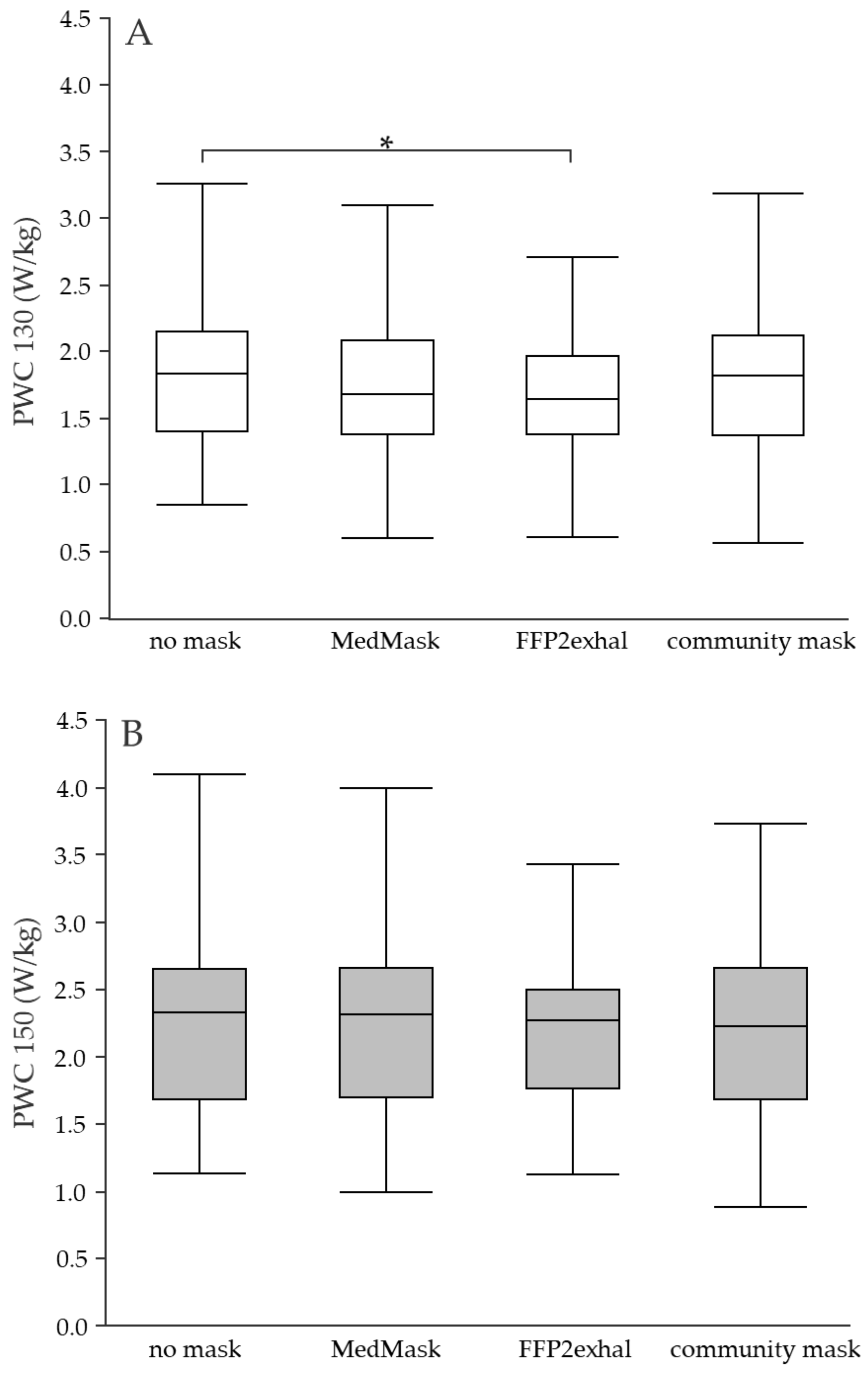
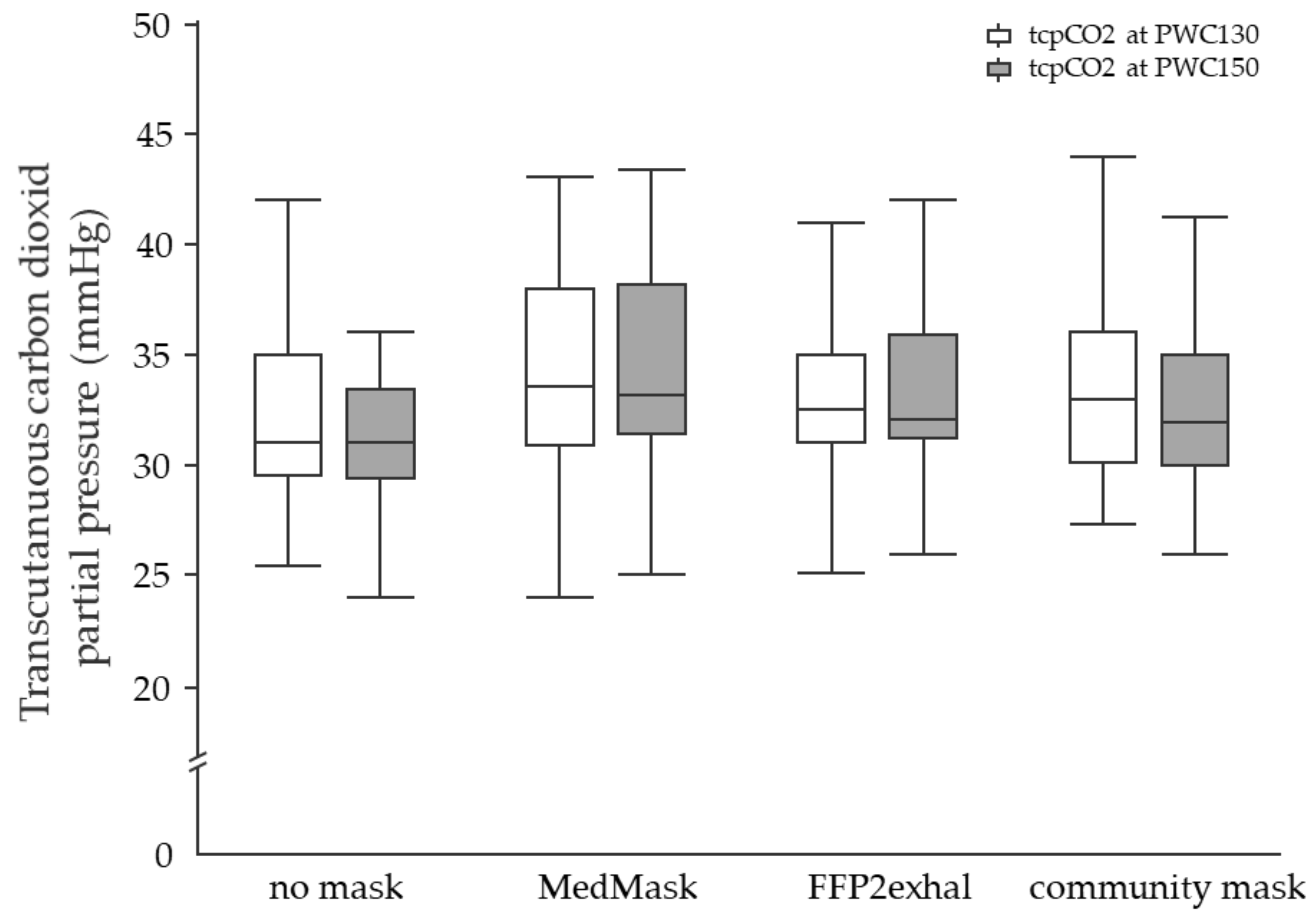
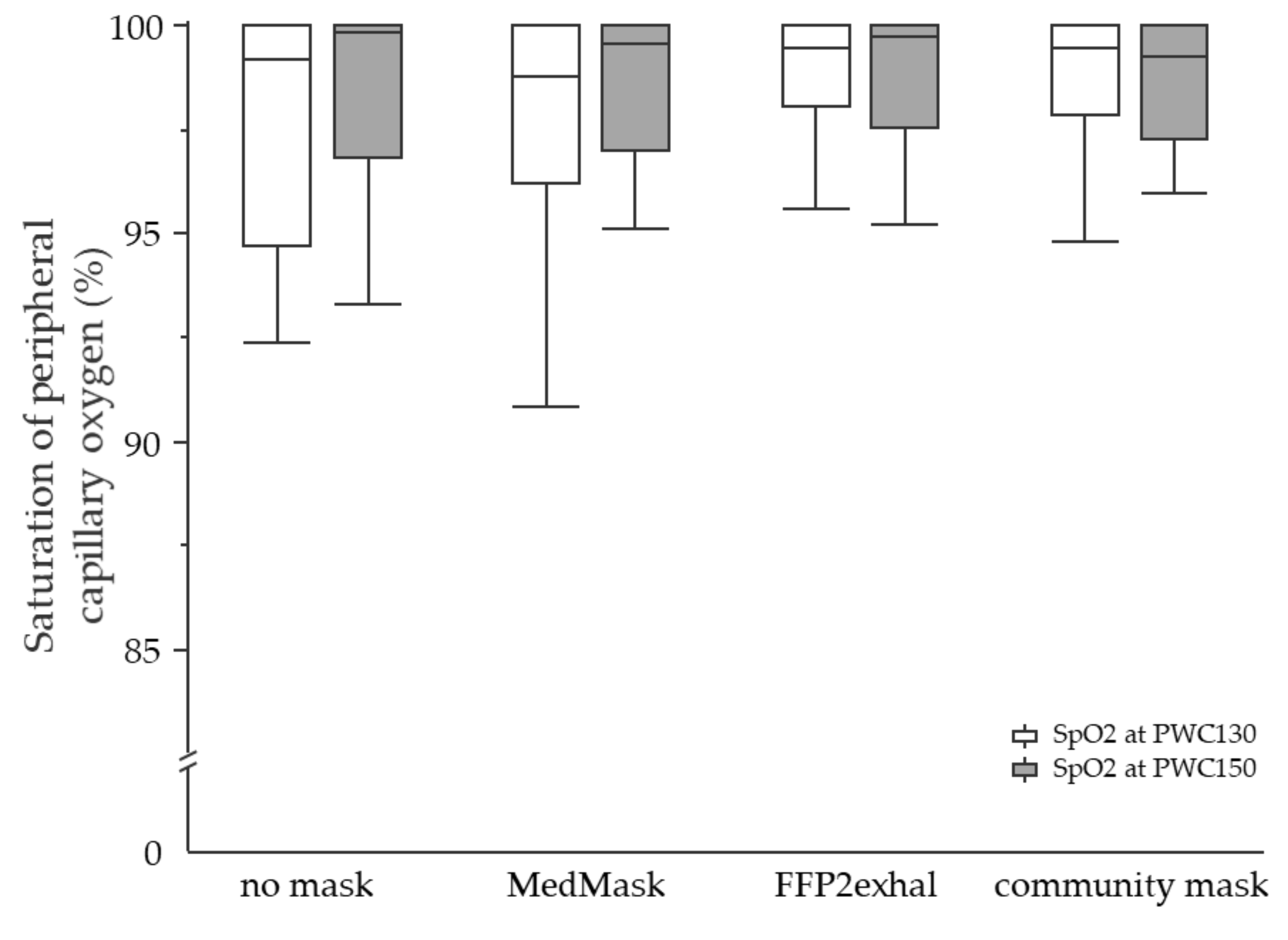
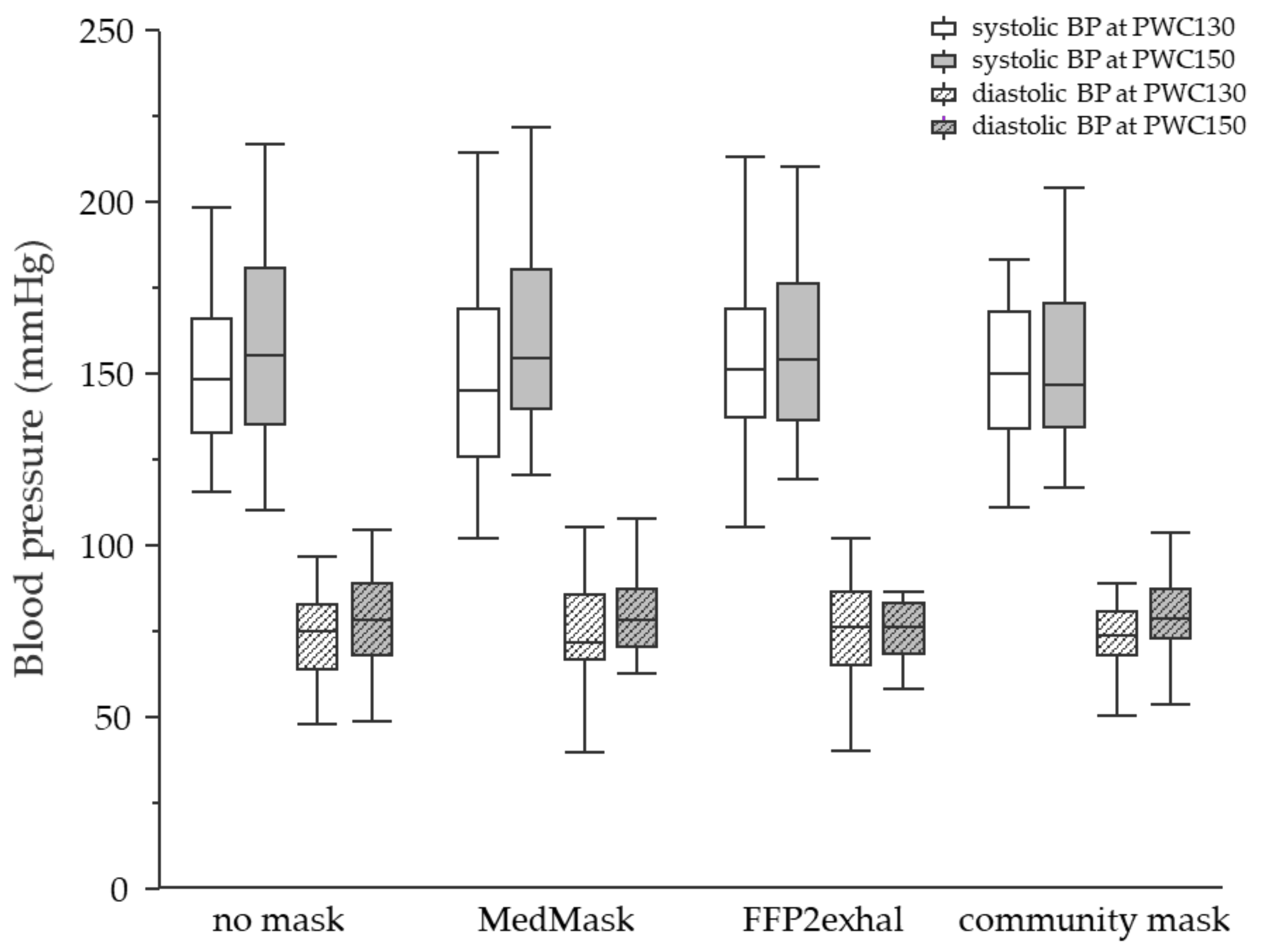

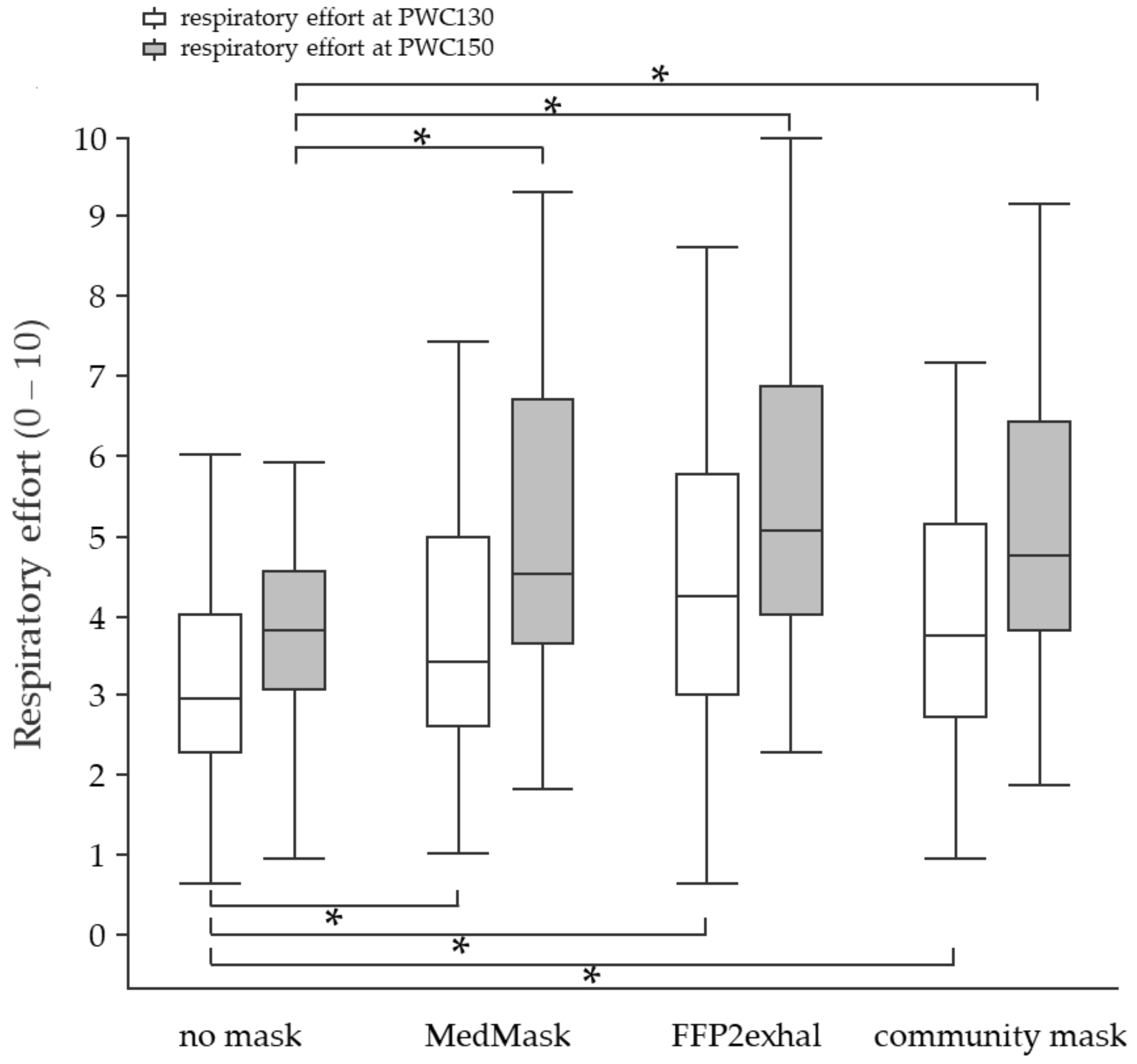
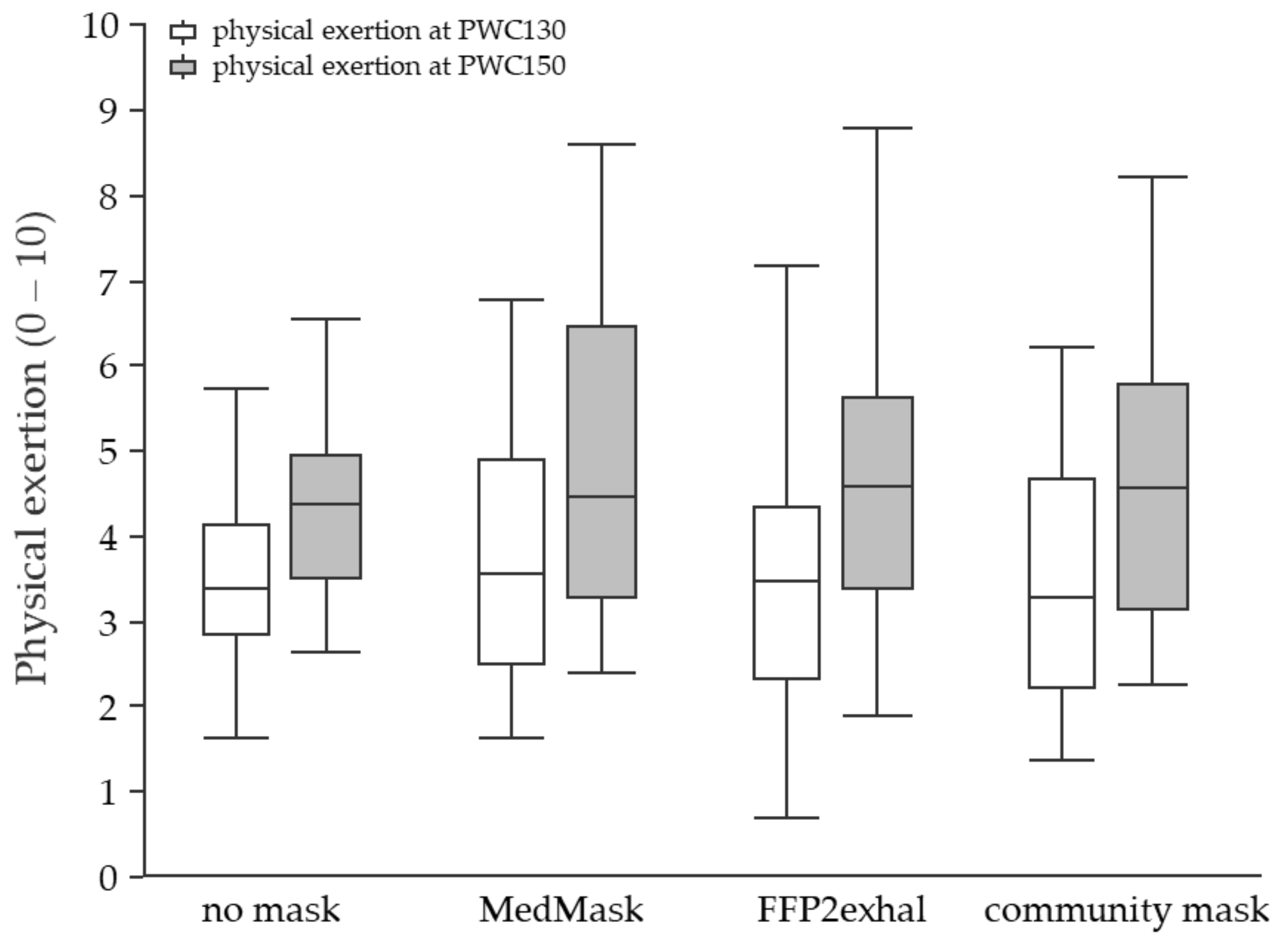
| Parameter | Overall | Fitness Level 1 | Fitness Level 2 | Fitness Level 3 | ||
|---|---|---|---|---|---|---|
| PWCmax | (W/kg) | mean SD | 3.3 1.0 | 2.3 * 0.3 | 3.2 * 0.3 | 4.4 * 0.6 |
| sex | (n, %) | overall men women | 39, 100% 20, 51.3% 19, 48.7% | 13, 33.3% 6, 15.4% 7, 18.0% | 13, 33.3% 7, 18.0% 6, 15.4% | 13, 33.3% 7, 18.0% 6, 15.4% |
| smokers | (n, %) | 4, 10.3% | 1, 2.6% | 3, 7.7% | 0, 0% | |
| age | (years) | mean SD | 38.2 14.2 | 43.1 16.9 | 43.8 13.1 | 28.7 ** 6.1 |
| BMI | (kg/m²) | mean SD | 23.7 2.4 | 25.0 3.1 | 23.5 1.9 | 22.5 * 1.4 |
| Duration of current occupational profession | (years) | mean SD | 10.5 10.7 | 13.8 13.5 | 12.9 9.9 | 5.0 ** 5.5 |
| Weekly working time | (hours) | mean SD | 34.3 13.2 | 30.5 14.2 | 32.6 11.3 | 39.7 13.2 |
| Physical activity at work | (minutes/week) | mean SD | 491.8 589.0 | 424.3 488.1 | 609.3 726.6 | 441.7 556.5 |
| Physical activity leisure time | (minutes/week) | mean SD | 206.4 207.3 | 99.1 103.7 | 112.3 100.2 | 407.7 ** 222.2 |
| Model | Outcome Parameter | Dependent Variable | Degree of Freedom | F-Value | p-Value |
|---|---|---|---|---|---|
| 1 | PWC130 | Face mask condition | 1 | 3.472 | 0.07 |
| 2 | PWC130 | Face mask condition | 1 | 3.491 | 0.07 |
| sex | 1 | 13.245 | 0.001 |
| Outcome Parameter | No Mask | MedMask | FFP2exhal | Community Mask | ||||
|---|---|---|---|---|---|---|---|---|
| Mean | SD | Mean | SD | Mean | SD | Mean | SD | |
| PWC130 (W/kg) | 1.91 | 0.70 | 1.84 | 0.72 | 1.74 | 0.65 | 1.83 | 0.70 |
| PWC150 (W/kg) | 2.35 | 0.83 | 2.32 | 0.81 | 2.28 | 0.76 | 2.35 | 0.89 |
| tcpCO2 at PWC130 (mmHg) | 32.37 | 6.22 | 34.07 | 4.28 | 33.64 | 4.29 | 33.70 | 4.48 |
| tcpCO2 at PWC150 (mmHg) | 31.18 | 6.15 | 34.33 | 4.70 | 33.45 | 4.54 | 32.78 | 4.29 |
| SpO2 at PWC 130 (%) | 97.30 | 3.74 | 97.42 | 3.38 | 98.29 | 2.94 | 97.90 | 4.03 |
| SpO2 at PWC 150 (%) | 97.45 | 4.84 | 98.11 | 3.02 | 98.66 | 2.17 | 98.18 | 2.71 |
| Systolic blood pressure at PWC130 (mmHg) | 151.00 | 28.67 | 149.34 | 29.18 | 152.38 | 29.30 | 150.79 | 25.75 |
| Systolic blood pressure at PWC150 (mmHg) | 157.45 | 28.28 | 160.80 | 28.54 | 155.11 | 24.18 | 152.51 | 24.34 |
| Dyastolic blood pressure at PWC130 (mmHg) | 75.19 | 13.81 | 74.76 | 14.37 | 76.13 | 15.84 | 74.32 | 10.57 |
| Dyastolic blood pressure PWC150 (mmHg) | 78.61 | 14.48 | 77.88 | 14.15 | 77.02 | 12.24 | 79.22 | 11.68 |
| Breathing frequency at PWC130 (1/min) | 22.34 | 5.79 | 21.60 | 4.59 | 21.76 | 10.97 | 21.38 | 4.53 |
| Breathing frequency at PWC150 (1/min) | 24.15 | 6.64 | 23.09 | 4.74 | 22.26 | 4.87 | 23.00 | 4.67 |
| Perceived respiratory effort at PWC130 (0–10) | 3.19 | 1.52 | 3.89 | 1.70 | 4.30 | 1.92 | 3.96 | 1.59 |
| Perceived respiratory effort at PWC150 (0–10) | 3.97 | 1.71 | 5.12 | 1.92 | 5.34 | 1.95 | 5.12 | 1.83 |
| Perceived physical exertion at PWC130 (0–10) | 3.51 | 1.25 | 3.80 | 1.67 | 3.59 | 1.83 | 3.42 | 1.39 |
| Perceived physical exertion at PWC150 (0–10) | 4.47 | 1.35 | 4.87 | 1.70 | 4.59 | 1.83 | 4.51 | 1.66 |
Publisher’s Note: MDPI stays neutral with regard to jurisdictional claims in published maps and institutional affiliations. |
© 2022 by the authors. Licensee MDPI, Basel, Switzerland. This article is an open access article distributed under the terms and conditions of the Creative Commons Attribution (CC BY) license (https://creativecommons.org/licenses/by/4.0/).
Share and Cite
Steinhilber, B.; Seibt, R.; Gabriel, J.; Brountsou, J.; Muljono, M.; Downar, T.; Bär, M.; Bonsch, R.; Brandt, A.; Martus, P.; et al. Effects of Face Masks on Physical Performance and Physiological Response during a Submaximal Bicycle Ergometer Test. Int. J. Environ. Res. Public Health 2022, 19, 1063. https://doi.org/10.3390/ijerph19031063
Steinhilber B, Seibt R, Gabriel J, Brountsou J, Muljono M, Downar T, Bär M, Bonsch R, Brandt A, Martus P, et al. Effects of Face Masks on Physical Performance and Physiological Response during a Submaximal Bicycle Ergometer Test. International Journal of Environmental Research and Public Health. 2022; 19(3):1063. https://doi.org/10.3390/ijerph19031063
Chicago/Turabian StyleSteinhilber, Benjamin, Robert Seibt, Julia Gabriel, Joulia Brountsou, Markus Muljono, Tomasz Downar, Mona Bär, Rosina Bonsch, Adrian Brandt, Peter Martus, and et al. 2022. "Effects of Face Masks on Physical Performance and Physiological Response during a Submaximal Bicycle Ergometer Test" International Journal of Environmental Research and Public Health 19, no. 3: 1063. https://doi.org/10.3390/ijerph19031063
APA StyleSteinhilber, B., Seibt, R., Gabriel, J., Brountsou, J., Muljono, M., Downar, T., Bär, M., Bonsch, R., Brandt, A., Martus, P., & Rieger, M. A. (2022). Effects of Face Masks on Physical Performance and Physiological Response during a Submaximal Bicycle Ergometer Test. International Journal of Environmental Research and Public Health, 19(3), 1063. https://doi.org/10.3390/ijerph19031063






